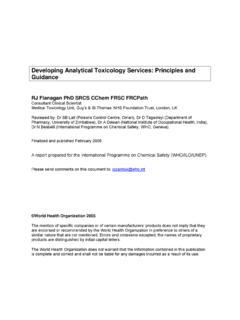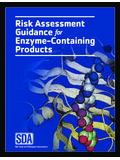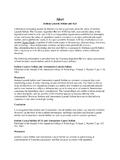Transcription of CHAPTER 98 SELENIUM - goldfrankstoxicology.com
1 1316 CHAPTER 98 SELENIUM Diane P. Calello SELENIUM (Se) Atomic number = 34 Atomic weight = daltons Normal concentrations Whole blood = mg/L ( mol/L) Serum = mg/L ( mol/L) Urine < mg/L (< mol/L) Hair < g/g ( mol/L) SELENIUM was discovered by J ns Berzelius in 1817 as a contaminant of sulfuric acid vats that caused illness in Swedish factory workers. He originally believed it to be the element tellurium (from the Latin tellus , earth ), but on finding it to be an entirely new, yet similar, element, he named it from the Greek selene , moon. SELENIUM has unusual light-sensitive electrical conductive properties, leading to its widespread use in industry. It is both an essential component of the human diet and a deadly poison. HISTORY AND EPIDEMIOLOGY Much of what is known about SELENIUM centers around its role as an essential trace element required in the diet of most living things, not around its toxic properties.
2 In the 1970s, it was discovered to be an essential cofactor of the enzyme glutathione peroxidase. Keshan disease, an endemic cardiomyopathy associated with multifocal myonecro-sis, periacinar pancreatic fibrosis, and mitochondrial disruption, was described in 1979 in Chinese women and children who chronically con-sumed a SELENIUM -poor diet. 9 Kashin-Beck disease, a disease causing short-ened stature from chondrocyte necrosis, is described in young children in Russia, China, and Korea; although other factors are also likely involved, partial improvement results from with SELENIUM supplementation. 2 These observations prompted the establishment, in 1980, of the United States recommended daily allowance (RDA) of SELENIUM . Taking into account the level of supplementation required to achieve optimal glutathione peroxidase activity in SELENIUM -deficient study populations, as well as the amounts required to cause toxicity, the recommendation calls for 55 g/d.
3 Deficiency occurs when daily intake falls below 20 g/d. 9 Chronic SELENIUM toxicity, or selenosis, has occurred throughout history. Described first in animals, the acute syndrome of blind stag-gers and the more chronic alkali disease affected livestock eating highly seleniferous plants. Findings included blindness, walking in circles, anorexia, weight loss, ataxia, and dystrophic hooves. Humans in seleniferous areas of China and Venezuela develop similar integumen-tary symptoms (dermatitis, hair loss, and nail changes) at an intake of approximately 6000 g/d, which is more than 100 times the RDA. 4, 36 In recent years, there have been several outbreaks of chronic SELENIUM toxicity related to improperly packaged dietary supplements. 14, 35, 42 SELENIUM is widely distributed throughout the earth s crust, usually substituting for sulfur in sulfide ores such as marcasite (FeS 2 ), arsenopyrite (FeAsS), and chalcopyrite (CuFeS 2 ).
4 It is found in the soil where it has leeched from bedrock, in groundwater, and in volcanic gas. The highest soil concentrations of SELENIUM in the United States are in the Midwest and West. Dietary SELENIUM is easily obtained through meats, grains, and cereals. Brazil nuts, grown in the foothills of the highly seleniferous Andes Mountains, contain the highest con-centration measured in food, but chronic SELENIUM toxicity from Brazil nuts has not been reported. 2 In industry, SELENIUM is generated primarily as a byproduct of electrolytic copper refining and in the combustion of rubber, paper, municipal waste, and fossil fuels. In general, SELENIUM compounds are used in glass manufacture and coloring, photography and xerography, rubber vulcanization, and as insecticides and fungicides. SELENIUM sulfide is the active ingredient in many antidandruff shampoos. Gun bluing solution, used in the care of firearms to restore the natural color to the gun barrel, is composed of selenious acid in combination with cupric sulfate in hydrochloric acid, nitric acid, copper nitrate, or methanol.
5 Tables 98 1 and 98 2 list features and regulatory standards of common SELENIUM compounds. CHEMICAL PRINCIPLES SELENIUM is a nonmetal element of group VIA of the periodic table along with oxygen, sulfur, tellurium, and polonium. SELENIUM exists in elemental, organic, and inorganic forms, with four important oxidation states: selenide (Se 2 ), elemental (Se 0 ), selenite (Se +4 ), and selenate (Se +6 ). Solubility in water generally increases with oxidation state. SELENIUM behaves similarly to sulfur in its tendency to form compounds and in biologic systems 2 and is both photovoltaic (able to convert light to electricity) and photoconductive (conducts electricity faster in bright light), which has led to its use in photography, xerography, and solar cells. At least three solid allotropes of elemental SELENIUM are described: grey SELENIUM , which predominates at room temperature; red crys-talline SELENIUM ; and a red amorphous powder.
6 2 In general, toxicity from elemental SELENIUM is rare and only occurs from long-term expo-sure. Hydrogen selenide (H 2 Se) is formed from the reaction of water or acids with metal selenides or from the reaction of hydrogen with soluble SELENIUM compounds; at room temperature, it exists in gaseous form and results in industrial inhalation exposures. The organic alkyl selenides (dimethylselenide, trimethylselenide) are the least toxic and are byproducts of endogenous SELENIUM detoxification (methylation). Inorganic salts and acids are responsible for all cases of acute toxicity. Selenious acid (H 2 SeO 3 ), generated from the reaction of SELENIUM dioxide with water, is the most toxic form of SELENIUM ; ingestion of selenious acid is often fatal. PHARMACOLOGY AND PATHOPHYSIOLOGY SELENIUM exists in one of three forms in the body. First, selenoproteins contain selenocysteine residues and play specific SELENIUM -dependent roles primarily in oxidation reduction reactions.
7 Second, nonspecific plasma proteins bind and may aid in transport of SELENIUM ; they may directly bind SELENIUM (albumin, globulins) or contain it as seleno-cysteine or selenomethionine in place of cysteine and methionine, respectively. Third, there are several inorganic forms of SELENIUM in transit throughout the body, such as selenate, alkyl selenides, and elemental SELENIUM (Se ). The known specific selenoproteins glutathione peroxidase, iodothy-ronine 5-deiodinases, and thioredoxin reductase each contain a seleno-cysteine residue at the active site. The most studied of these is glutathione peroxidase, which is responsible for detoxification of reactive oxygen species. Using reduced glutathione (GSH) as a substrate, glutathione 13163/17/10 4:57:43 AM3/17/10 4:57:43 AM1317 CHAPTER 98 SELENIUM peroxidase catalyses the reduction of hydrogen peroxide to water and oxidized glutathione (GSSG, or glutathione disulfide); the reaction occurs by concomitant oxidation of the selenocysteine unit on the enzyme.
8 3, 32 Other selenocysteine-containing proteins, such as thioredoxin reductase, also appear to have antioxidant properties. The selenocysteine-containing thyroid hormone deiodinases are responsible for the conversion of thyroxine (T 4 ) to the active triiodothyronine (T 3 ) form. In SELENIUM deficiency, glutathione peroxidase activity is decreased, and GSH and glutathione-S transferases are increased. 32 Consequently, SELENIUM -deficient rats are more resistant to substances detoxified by glutathione-S transferase, such as acetaminophen and aflatoxin B 5 , and less resistant to other prooxidants, such as nitrofurantoin, diquat, and paraquat. 5 In animal studies of metal toxicity, SELENIUM also appears to modify the effects of silver, cadmium, arsenic, copper, zinc, mercury, and fluoride; conversely, vanadium, tellurium, and arsenic modify the effects of SELENIUM deficiency or excess. 13, 16, 18, 28, 36 Although it is proposed that this is accomplished through the formation of insoluble SELENIUM metal complexes, these relationships are not entirely understood.
9 11 Less is known about the biochemical mechanism of SELENIUM toxicity, and what is known is from in vitro data. Paradoxically, excess SELENIUM causes oxidative stress, presumably as a result of prooxidant selenide (R-Se ) anions. In addition, the replacement of SELENIUM for sulfur in enzymes of cellular respiration may cause mitochondrial disruption, and the substitution of selenomethionine in place of methionine may interfere with protein synthesis. Integumentary effects are also most likely a result of SELENIUM interpolation into disulfide bridges of struc-tural proteins such as keratin. 40 PHARMACOKINETICS AND TOXICOKINETICS Gastrointestinal (GI) absorption varies with the species of SELENIUM , and human data are limited. Elemental SELENIUM is the least bioavail-able ( 50%), followed by inorganic selenite and selenate salts (75%) 23 ; selenious acid is quite well absorbed in the lungs and GI tract ( 85% in animal studies 8 ).
10 Organic SELENIUM compounds are the best absorbed at approximately 90% as determined by isotope tracers in human studies. 2, 21 Inhalational absorption was documented in a group of workers exposed to SELENIUM dioxide and hydrogen selenide gas, 2, 15 but quanti-tative inhalation studies in humans are not available. Dermal absorption appears to be limited. SELENIUM disulfide shampoos are not systemically absorbed as measured by urinary SELENIUM levels 8 except in cases of repeated use on excoriated skin. 31 The toxic dose of SELENIUM varies widely between SELENIUM com-pounds, as demonstrated by LD 50 (median lethal dose for 50% of test subjects) animal studies, 36 making milligram per kilogram exposure estimates difficult to interpret. Elemental SELENIUM has no reported adverse effects in acute overdose, although long-term exposure may be harmful. The SELENIUM salts, particularly selenite, are more acutely toxic, as is SELENIUM oxide (SeO 2 ) through its conversion to selenious acid in the presence of water.





